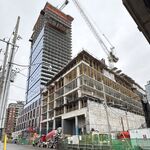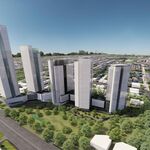A
AlvinofDiaspar
Guest
From the Post:
How high can high-rise count go, ask neighbours
Yonge-Eglinton
By James Cowan
Residents in the Yonge-Eglinton area, earmarked for development in Ontario's new growth plan, are wondering how many more high-rise condominiums their community can handle.
The province last week unveiled its plan to contain sprawl in the Golden Horseshoe, including designating 25 hot spots where residential and business development will be focused. Included on this list of "urban growth" hubs is Yonge-Eglinton centre, a community with an uneasy relationiship with intensification.
Residents rallied unsuccessfully five years ago to block Minto's plan to build a 51 storey condominium. With the tower under construction and other projects on the way, some locals are worried their community will not be able to accomodate the intensification proposed in the province's plan.
"You really start to wonder how much more you can put into that general area," said George Millbrandt, co-chairman of the Federation of North Toronto Residents Association. "You can keep on packing things in, but then other things start sufferning, be it hard or soft services."
Karen Stintz, the local councillor, argued residents are entitled to be wary of the province's 25 year plan.
"The residents of Toronto who have been living with intensification are not seeing the benefits," she said. "They are not seeing improvements to their public transit, they are seeing increased congestion, they are seeing increased community times for jobs."
Toronto has already designated Yonge and Eglinton as an rea for increased development under its official plan. While planners argue the neighbourhood's proximity to subway makes it an ideal choice for intensification, Mr, Millbrandt said other factors must be taken into consideration as well.
"It's good to try to get people to live and to work in areas with access to public transporation, but our concern is the overall infrastructure," he said. "Things just have a finite capacity, whether its roads or sewers or water or sewage, it's easy to get to the position of overloading those facilities."
A spokesman for David Caplan, Minister of Public Infrastructure Renewal, did not return calls yesterday. The government is investing $7.5 billion in infrastructure across the Golden Horseshoe, including $4.1 billion towards public transit.
Locations in North York, Etobicoke, Scarborough and the city's downtown have also been identified as urban growth centres. Ms. Stintz said the province's plan wil only encourage more controversial projects like the Minto development. She noted there are already signs that developers are buying up land occupied by single family homes for the construction of towers.
_________________________________________________
Indeed, so I suppose it would pleases him to no end when transit gets priority treatment on local arterial roads; new sewer lines be built; schools and libraries get expanded such that intensification en masse can occur? Or are we playing the "let's keep infrastructure at a level that barely suffices for existing land uses so no further change is possible" game of veiled NIMBYism?
I can't wait!
AoD
How high can high-rise count go, ask neighbours
Yonge-Eglinton
By James Cowan
Residents in the Yonge-Eglinton area, earmarked for development in Ontario's new growth plan, are wondering how many more high-rise condominiums their community can handle.
The province last week unveiled its plan to contain sprawl in the Golden Horseshoe, including designating 25 hot spots where residential and business development will be focused. Included on this list of "urban growth" hubs is Yonge-Eglinton centre, a community with an uneasy relationiship with intensification.
Residents rallied unsuccessfully five years ago to block Minto's plan to build a 51 storey condominium. With the tower under construction and other projects on the way, some locals are worried their community will not be able to accomodate the intensification proposed in the province's plan.
"You really start to wonder how much more you can put into that general area," said George Millbrandt, co-chairman of the Federation of North Toronto Residents Association. "You can keep on packing things in, but then other things start sufferning, be it hard or soft services."
Karen Stintz, the local councillor, argued residents are entitled to be wary of the province's 25 year plan.
"The residents of Toronto who have been living with intensification are not seeing the benefits," she said. "They are not seeing improvements to their public transit, they are seeing increased congestion, they are seeing increased community times for jobs."
Toronto has already designated Yonge and Eglinton as an rea for increased development under its official plan. While planners argue the neighbourhood's proximity to subway makes it an ideal choice for intensification, Mr, Millbrandt said other factors must be taken into consideration as well.
"It's good to try to get people to live and to work in areas with access to public transporation, but our concern is the overall infrastructure," he said. "Things just have a finite capacity, whether its roads or sewers or water or sewage, it's easy to get to the position of overloading those facilities."
A spokesman for David Caplan, Minister of Public Infrastructure Renewal, did not return calls yesterday. The government is investing $7.5 billion in infrastructure across the Golden Horseshoe, including $4.1 billion towards public transit.
Locations in North York, Etobicoke, Scarborough and the city's downtown have also been identified as urban growth centres. Ms. Stintz said the province's plan wil only encourage more controversial projects like the Minto development. She noted there are already signs that developers are buying up land occupied by single family homes for the construction of towers.
_________________________________________________
"It's good to try to get people to live and to work in areas with access to public transporation, but our concern is the overall infrastructure," he said. "Things just have a finite capacity, whether its roads or sewers or water or sewage, it's easy to get to the position of overloading those facilities."
Indeed, so I suppose it would pleases him to no end when transit gets priority treatment on local arterial roads; new sewer lines be built; schools and libraries get expanded such that intensification en masse can occur? Or are we playing the "let's keep infrastructure at a level that barely suffices for existing land uses so no further change is possible" game of veiled NIMBYism?
She noted there are already signs that developers are buying up land occupied by single family homes for the construction of towers.
I can't wait!
AoD





